2014 MITSUBISHI OUTLANDER SPORT brake
[x] Cancel search: brakePage 339 of 388

Cleaning the exterior of your vehicle10-4 Vehicle care
10
Sea water contains salt, which generallyaccelerates corrosion of both ferrous and non-ferrous materials. Wind born spray from thesea can distribute salt for a distance of up to20 km from the shore line with prevailing on-shore winds, although the effect is generallyworse within 2 km of the shore. Salt spraycovers roads, and may be passed to your vehi-cle as dust, or as salt spray after rain. For thisreason it is important to wash all the vehicleincluding the underside (not forgetting theplug-in hybrid EV system bay and plug-inhybrid EV system bay components). See sec-tion entitled “Engine compartment” for rec-ommended cleaning practices.Ensure you request a MITSUBISHIMOTORS Authorised Service Point to con-duct the scheduled Preventative Maintenancecorrosion inspection if you live within 20 kmof the sea. Sea water spray in coastal condi-tions
WA R N I N G�zDo not wash the vehicle while charging thetraction battery.Doing so could cause a fire or an electricshock.
�zBefore washing the vehicle, make surethat the charging lid
and the inner lid are
completely closed.If the lid is open, the charging unit isexposed to water, resulting in a fire or anelectric shock.CAUTION�zWhen washing the under
side of your vehicle
or wheel, be careful not to injure your hands.�zIf your vehicle has rain sensor wipers, placethe wiper switch lever in the “OFF” positionto deactivate the rain sensor before washingthe vehicle. Otherwise, the wipers will oper-ate in the presence of water spray on thewindscreen and may get damaged as a result.�zRefrain from excessively using a car wash asits brushes may scratch the paint surface,causing it to lose its gloss. Scratches will beespecially visible on da
rker coloured vehi-
cles.�zNever spray or splash
water on the electrical
components in the engine compartment.Doing so could have an adverse effect on theplug-in hybrid EV system startability.Exercise caution also when washing theunderbody; be careful not to spray water intothe engine compartment.WA R N I N G
�zSome types of hot wa
ter washing equipment
apply high pressure and
heat to the vehicle.
They may cause heat distortion and damageto the vehicle resin parts and may result inflooding of the vehicle interior.Therefore;•Maintain a distance of approx. 70 cm ormore between the vehicle body and thewashing nozzle.•When washing around the door glass, holdthe nozzle at a distance of more than 70 cmand at right angles to the glass surface.
�zAfter washing the vehicle, drive the vehicleslowly while lightly depressing the brakepedal several times in order to dry out thebrakes.Leaving the brakes wet could result inreduced braking performance. Also, there isa possibility that they could freeze up orbecome inoperative due
to rust, rendering the
vehicle unable to move.�zUsing an automatic car wash, pay attentionto the following items, referring to the opera-tion manual or consulting a car wash opera-tor. If the following procedure is notfollowed, it could result in damage to yourvehicle.•The outside rear-view mirrors are retracted.•The antenna is removed.•The wiper arms are secured in place withtape.CAUTION
BK0203201EN.book 4 ページ 2013年11月19日 火曜日 午前11時50分
Page 340 of 388
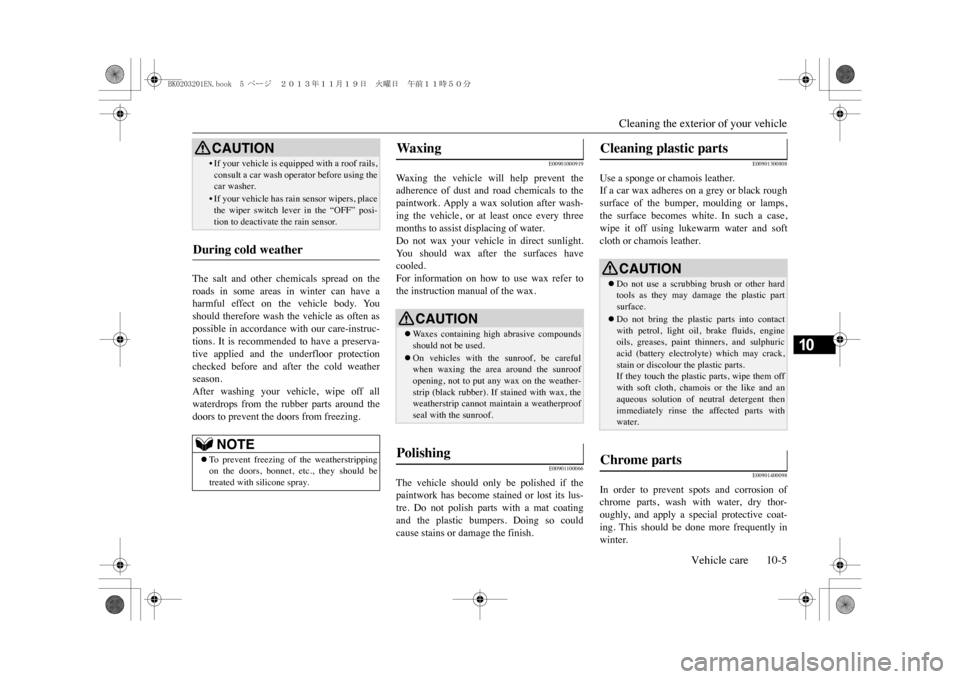
Cleaning the exterior of your vehicle
Vehicle care 10-5
10
The salt and other chemicals spread on theroads in some areas in winter can have aharmful effect on the vehicle body. Youshould therefore wash the vehicle as often aspossible in accordance with our care-instruc-tions. It is recommended to have a preserva-tive applied and the underfloor protectionchecked before and after the cold weatherseason.After washing your vehicle, wipe off allwaterdrops from the rubber parts around thedoors to prevent the doors from freezing.
E00901000919
Wa x i n g t h e v e h i c l e w i l l h e l p p r e v e n t t h eadherence of dust and road chemicals to thepaintwork. Apply a wax solution after wash-ing the vehicle, or at least once every threemonths to assist di
splacing of water.
Do not wax your vehicle in direct sunlight.Yo u s h o u l d w a x a f t e r t h e s u r f a c e s h a v ecooled.For information on how to use wax refer tothe instruction manual of the wax.
E00901100066
The vehicle should only be polished if thepaintwork has become stained or lost its lus-tre. Do not polish parts with a mat coatingand the plastic bumpers. Doing so couldcause stains or damage the finish.
E00901300808
Use a sponge or chamois leather.If a car wax adheres on a grey or black roughsurface of the bumper, moulding or lamps,the surface becomes white. In such a case,wipe it off using lukewarm water and softcloth or chamois leather.
E00901400098
In order to prevent spots and corrosion ofchrome parts, wash with water, dry thor-oughly, and apply a special protective coat-ing. This should be done more frequently inwinter.
•If your vehicle is equi
pped with a roof rails,
consult a car wash opera
tor before using the
car washer.•If your vehicle has rain
sensor wipers, place
the wiper switch lever in the “OFF” posi-tion to deactivate the rain sensor.
During cold weather
NOTE
�zTo p r e v e n t f r e e z i n g o f
the weatherstripping
on the doors, bonnet, etc., they should betreated with silicone spray.CAUTION
Wa x in g
CAUTION�zWa x e s c o n t a i n i n g h i
gh abrasive compounds
should not be used.�zOn vehicles with the sunroof, be carefulwhen waxing the area around the sunroofopening, not to put any wax on the weather-strip (black rubber). If stained with wax, theweatherstrip cannot maintain a weatherproofseal with the sunroof.
Polishing
Cleaning plastic parts
CAUTION�zDo not use a scrubbing brush or other hardtools as they may damage the plastic partsurface.�zDo not bring the plastic parts into contactwith petrol, light oil,
brake fluids, engine
oils, greases, paint thinners, and sulphuricacid (battery electrolyte) which may crack,stain or discolour
the plastic parts.
If they touch the plastic
parts, wipe them off
with soft cloth, chamois or the like and anaqueous solution of neutral detergent thenimmediately rinse the affected parts withwater.
Chrome parts
BK0203201EN.book 5 ページ 2013年11月19日 火曜日 午前11時50分
Page 342 of 388
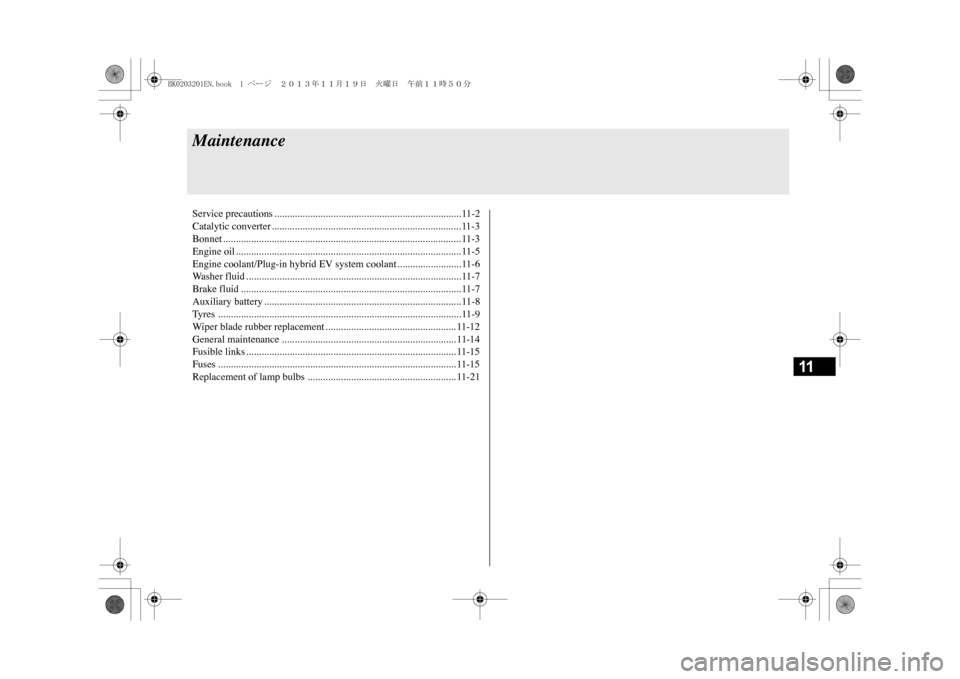
11
MaintenanceService precautions ......................................................................... 11-2Catalytic converter .......................................................................... 11-3Bonnet ............................................................................................. 11-3Engine oil ........................................................................................ 11-5Engine coolant/Plug-in hybrid EV system coolant ......................... 11-6Wa s h e r f l u i d . . . . . . . . . . . . . . . . . . . . . . . . . . . . . . . . . . . . . . . . . . . . . . . . . . . . . . . . . . . . . . . . . . . . . . . . . . . . . . . . . . . . 11 - 7Brake fluid ...................................................................................... 11-7Auxiliary battery ............................................................................. 11-8Ty r e s . . . . . . . . . . . . . . . . . . . . . . . . . . . . . . . . . . . . . . . . . . . . . . . . . . . . . . . . . . . . . . . . . . . . . . . . . . . . . . . . . . . . . . . . . . . . . . . 11 - 9Wiper blade rubber replacement ................................................... 11-12General maintenance .................................................................... 11-14Fusible links .................................................................................. 11-15Fuses ............................................................................................. 11-15Replacement of lamp bulbs .......................................................... 11-21
BK0203201EN.book 1 ページ 2013年11月19日 火曜日 午前11時50分
Page 344 of 388
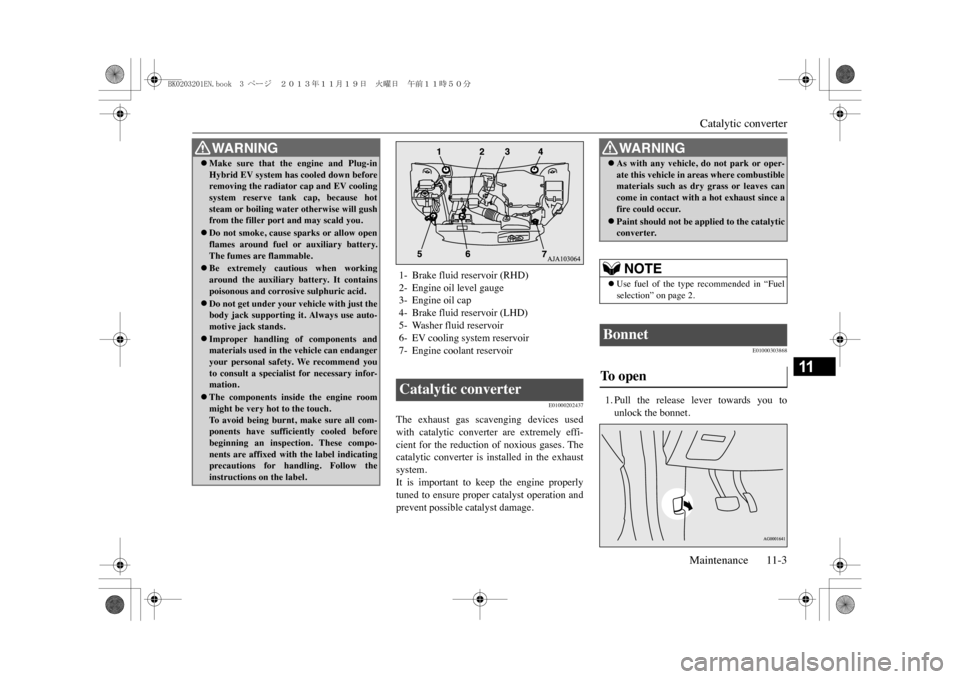
Catalytic converterMaintenance 11-3
11
E01000202437
The exhaust gas scavenging devices usedwith catalytic converter are extremely effi-cient for the reduction of noxious gases. Thecatalytic converter is installed in the exhaustsystem.It is important to keep the engine properlytuned to ensure proper catalyst operation andprevent possible catalyst damage.
E01000303868
1. Pull the release lever towards you tounlock the bonnet.
�zMake sure that the engine and Plug-inHybrid EV system has cooled down beforeremoving the radiator cap and EV coolingsystem reserve tank cap, because hotsteam or boiling water otherwise will gushfrom the filler port and may scald you.�zDo not smoke, cause sparks or allow openflames around fuel or auxiliary battery.The fumes are flammable.�zBe extremely cautious when workingaround the auxiliary battery. It containspoisonous and corrosive sulphuric acid.�zDo not get under your vehicle with just thebody jack supporting it. Always use auto-motive jack stands.�zImproper handling of
components and
materials used in the vehicle can endangeryour personal safety. We recommend youto consult a specialist for necessary infor-mation.�zThe components inside the engine roommight be very hot to the touch.To a v o i d b e i n g b u r n t , m a k e s u r e a l l c o m -ponents have sufficiently cooled beforebeginning an inspection. These compo-nents are affixed with the label indicatingprecautions for handling. Follow theinstructions on the label.WA R N I N G
1- Brake fluid reservoir (RHD)2- Engine oil level gauge3- Engine oil cap4- Brake fluid reservoir (LHD)5- Washer fluid reservoir6- EV cooling system reservoir7- Engine coolant reservoirCatalytic converter
WA R N I N G�zAs with any vehicle, do not park or oper-ate this vehicle in areas where combustiblematerials such as dry grass or leaves cancome in contact with a hot exhaust since afire could occur.�zPaint should not be applied to the catalyticconverter.NOTE
�zUse fuel of the type recommended in “Fuelselection” on page 2.
Bonnet To o p e n
BK0203201EN.book 3 ページ 2013年11月19日 火曜日 午前11時50分
Page 348 of 388
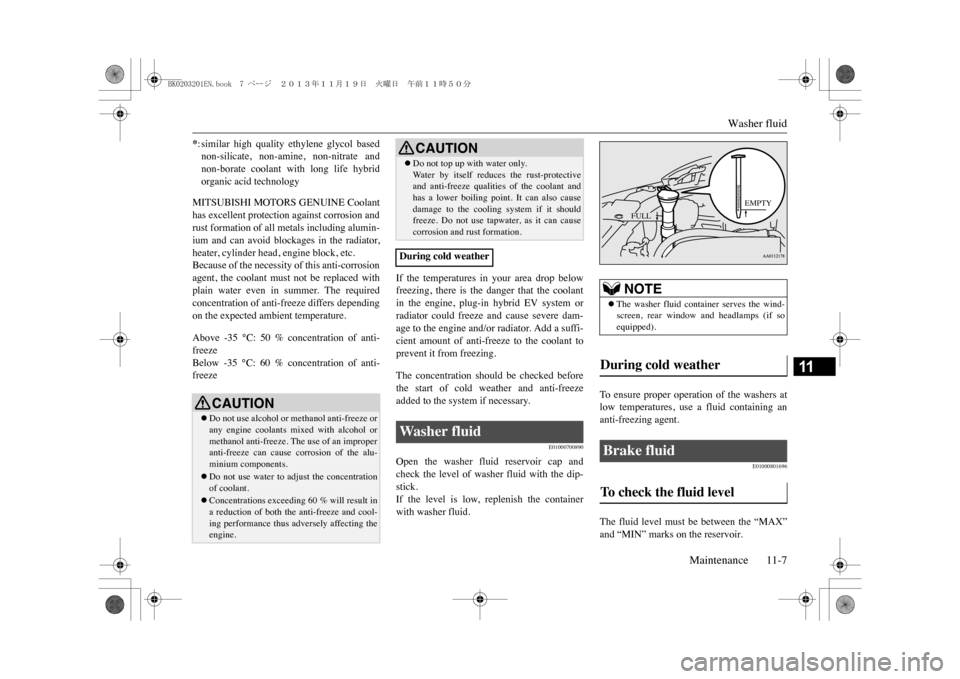
Washer fluid
Maintenance 11-7
11
MITSUBISHI MOTORS GENUINE Coolanthas excellent protection against corrosion andrust formation of all metals including alumin-ium and can avoid blockages in the radiator,heater, cylinder head, engine block, etc.Because of the necessity of this anti-corrosionagent, the coolant must not be replaced withplain water even in summer. The requiredconcentration of anti-freeze differs dependingon the expected ambient temperature.Above -35 °C: 50 % concentration of anti-freezeBelow -35 °C: 60 % concentration of anti-freeze
If the temperatures in your area drop belowfreezing, there is the danger that the coolantin the engine, plug-in hybrid EV system orradiator could freeze and cause severe dam-age to the engine and/or radiator. Add a suffi-cient amount of anti-freeze to the coolant toprevent it from freezing.The concentration should be checked beforethe start of cold weather and anti-freezeadded to the system if necessary.
E01000700890
Open the washer fluid reservoir cap andcheck the level of washer fluid with the dip-stick.If the level is low, replenish the containerwith washer fluid.
To e n s u r e p r o p e r o p e r a t i o n o f t h e w a s h e r s a tlow temperatures, use a fluid containing ananti-freezing agent.
E01000801696
The fluid level must be between the “MAX”and “MIN” marks on the reservoir.
*: similar high quality ethylene glycol basednon-silicate, non-amine, non-nitrate andnon-borate coolant with long life hybridorganic acid technologyCAUTION�zDo not use alcohol or methanol anti-freeze orany engine coolants
mixed with alcohol or
methanol anti-freeze. The use of an improperanti-freeze can cause corrosion of the alu-minium components.�zDo not use water to adjust the concentrationof coolant.�zConcentrations exceeding 60 % will result ina reduction of both the anti-freeze and cool-ing performance thus adversely affecting theengine.
�zDo not top up with water only.Wa t e r b y i t s e l f r e d u c e s t h e r u s t - p r o t e c t i v eand anti-freeze qualities of the coolant andhas a lower boiling point. It can also causedamage to the cooling system if it shouldfreeze. Do not use tapwater, as it can causecorrosion and rust formation.
During cold weatherWa s h e r f l u i d
CAUTION
NOTE
�zThe washer fluid container serves the wind-screen, rear window and headlamps (if soequipped).
During cold weather Brake fluid To c h e c k t h e f l u i d l e v e l
EMPTY
FULL
BK0203201EN.book 7 ページ 2013年11月19日 火曜日 午前11時50分
Page 349 of 388
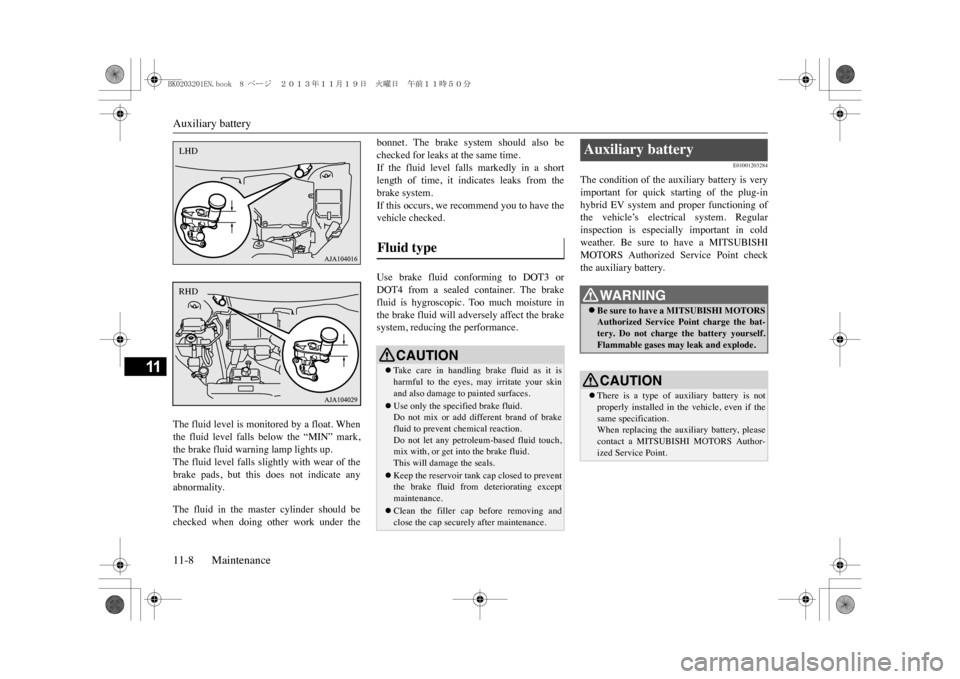
Auxiliary battery11-8 Maintenance
11
The fluid level is monitored by a float. Whenthe fluid level falls below the “MIN” mark,the brake fluid warning lamp lights up.The fluid level falls slightly with wear of thebrake pads, but this does not indicate anyabnormality.The fluid in the master cylinder should bechecked when doing other work under the
bonnet. The brake system should also bechecked for leaks at the same time.If the fluid level falls markedly in a shortlength of time, it indicates leaks from thebrake system.If this occurs, we recommend you to have thevehicle checked.Use brake fluid conforming to DOT3 orDOT4 from a sealed container. The brakefluid is hygroscopic. Too much moisture inthe brake fluid will adversely affect the brakesystem, reducing the performance.
E01001203284
The condition of the auxiliary battery is veryimportant for quick starting of the plug-inhybrid EV system and proper functioning ofthe vehicle’s electrical system. Regularinspection is especially important in coldweather. Be sure to have a MITSUBISHIMOTORS Authorized Service Point checkthe auxiliary battery.
LHDRHD
Fluid type
CAUTION�zTa k e c a r e i n h a n d l i n g b r a k e f l u i d a s i t i sharmful to the eyes,
may irritate your skin
and also damage to painted surfaces.�zUse only the specified brake fluid.Do not mix or add different brand of brakefluid to prevent chemical reaction.Do not let any petrol
eum-based fluid touch,
mix with, or get into the brake fluid.This will damage the seals.�zKeep the reservoir tank cap closed to preventthe brake fluid from deteriorating exceptmaintenance.�zClean the filler cap before removing andclose the cap securely after maintenance.
Auxiliary battery
WA R N I N G�zBe sure to have a MITSUBISHI MOTORSAuthorized Service Point charge the bat-tery. Do not charge the battery yourself.Flammable gases may leak and explode.CAUTION�zThere is a type of auxiliary battery is notproperly installed in the vehicle, even if thesame specification.When replacing the auxiliary battery, pleasecontact a MITSUBISHI MOTORS Author-ized Service Point.
BK0203201EN.book 8 ページ 2013年11月19日 火曜日 午前11時50分
Page 358 of 388
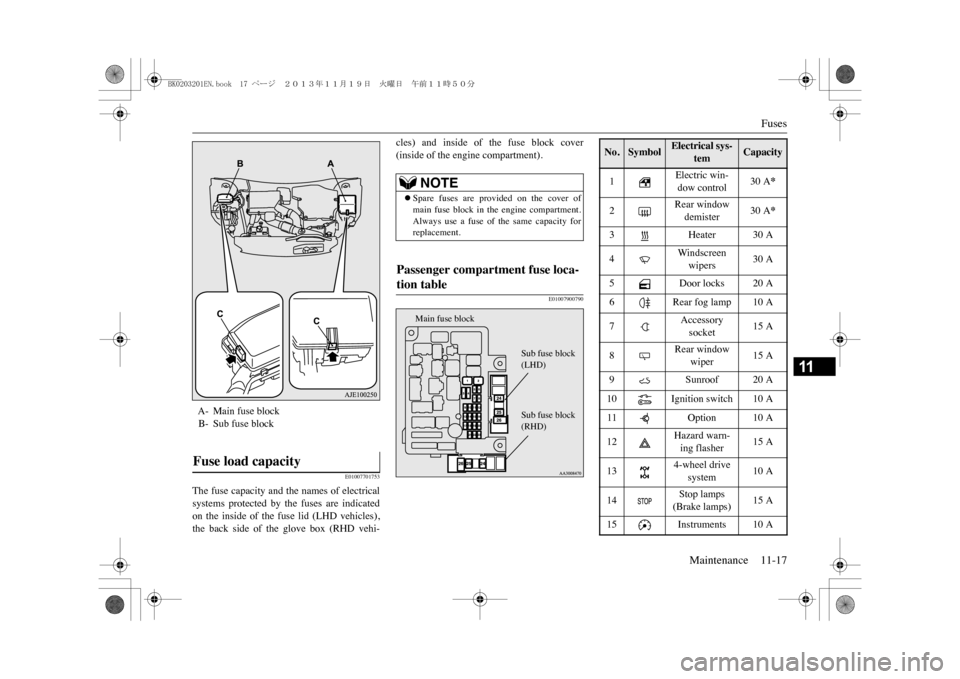
Fuses
Maintenance 11-17
11
E01007701753
The fuse capacity and the names of electricalsystems protected by the fuses are indicatedon the inside of the fuse lid (LHD vehicles),the back side of the glove box (RHD vehi-
cles) and inside of the fuse block cover(inside of the engine compartment).
E01007900790
A- Main fuse blockB- Sub fuse blockFuse load capacity
NOTE
�zSpare fuses are provided on the cover ofmain fuse block in the engine compartment.Always use a fuse of the same capacity forreplacement.
Passenger compartment fuse loca-tion table
Main fuse block
Sub fuse block(LHD)Sub fuse block(RHD)
No.
Symbol
Electrical sys-
tem
Capacity
1
Electric win-dow control
30 A
*
2
Rear window demister
30 A
*
3 Heater 30
A
4
Wi n dsc reen wipers
30 A
5
Door locks 20 A
6
Rear fog lamp 10 A
7
Accessory socket
15 A
8
Rear window
wiper
15 A
9
Sunroof 20 A
10 Ignition
switch 10
A
11 Option 10
A
12
Hazard warn-ing flasher
15 A
13
4-wheel drive
system
10 A
14
Stop lamps(Brake lamps)
15 A
15
Instruments 10 A
BK0203201EN.book 17 ページ 2013年11月19日 火曜日 午前11時50分
Page 360 of 388
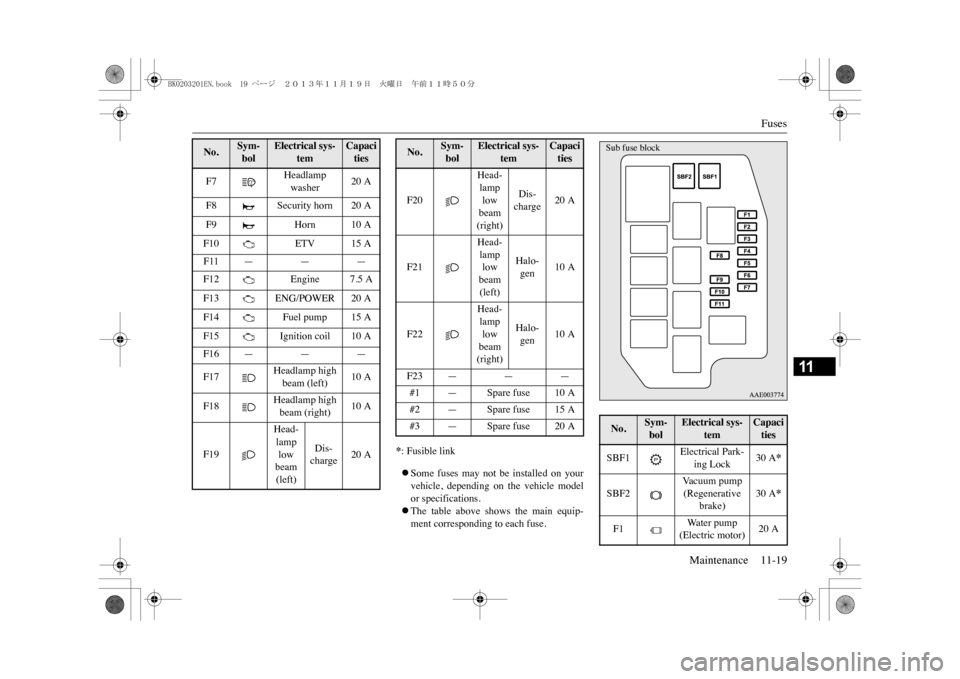
Fuses
Maintenance 11-19
11
*: Fusible link�zSome fuses may not be installed on yourvehicle, depending on the vehicle modelor specifications.�zThe table above shows the main equip-ment corresponding to each fuse.
F7
Headlamp washer
20 A
F8
Security horn 20 A
F9
Horn 10 A
F10
ETV 15 A
F11 — — —F12
Engine 7.5 A
F13
ENG/POWER 20 A
F14
Fuel pump 15 A
F15
Ignition coil 10 A
F16 — — —F17
Headlamp high beam (left)
10 A
F18
Headlamp high beam (right)
10 A
F19
Head-lamp low beam (left)
Dis-charge
20 A
No.
Sym-bol
Electrical sys-
tem
Capacities
F20
Head-lamp low beam (right)
Dis-charge
20 A
F21
Head-lamp low beam (left)
Halo-gen
10 A
F22
Head-lamp low beam (right)
Halo-gen
10 A
F23 — — —#1 — Spare fuse 10 A#2 — Spare fuse 15 A#3 — Spare fuse 20 ANo.
Sym-bol
Electrical sys-
tem
Capacities
No.
Sym-bol
Electrical sys-
tem
Capacities
SBF1
Electrical Park-
ing Lock
30 A
*
SBF2
Va c u u m p u m p (Regenerative
brake)
30 A
*
F1
Water pump (Electric motor)
20 A
Sub fuse block
BK0203201EN.book 19 ページ 2013年11月19日 火曜日 午前11時50分